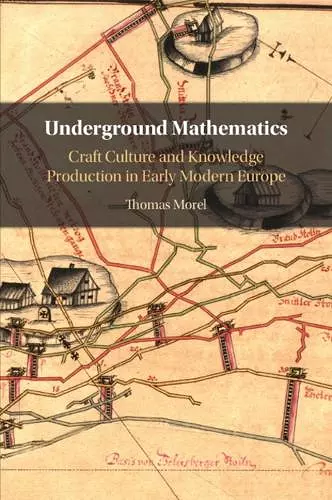Underground Mathematics
Craft Culture and Knowledge Production in Early Modern Europe
Format:Paperback
Publisher:Cambridge University Press
Published:29th May '25
Currently unavailable, and unfortunately no date known when it will be back
This paperback is available in another edition too:
- Hardback£78.00(9781009267304)

History of the development of practical mathematics in early modern Europe through the practice of mining.
Morel tells the story of subterranean geometry, a forgotten discipline that developed in the silver mines of early modern Europe where mining and metallurgy were of great significance. Through vivid case studies, he illustrates how geometry was used in metallic mines, from surveying to map-making, by practitioners using esoteric manuscripts.Thomas Morel tells the story of subterranean geometry, a forgotten discipline that developed in the silver mines of early modern Europe. Mining and metallurgy were of great significance to the rulers of early modern Europe, required for the silver bullion that fuelled warfare and numerous other uses. Through seven lively case studies, he illustrates how geometry was used in metallic mines by practitioners using esoteric manuscripts. He describes how an original culture of accuracy and measurement paved the way for technical and scientific innovations, and fruitfully brought together the world of artisans, scholars and courts. Based on a variety of original manuscripts, maps and archive material, Morel recounts how knowledge was crafted and circulated among practitioners in the Holy Roman Empire and beyond. Specific chapters deal with the material culture of surveying, map-making, expertise and the political uses of quantification. By carefully reconstructing the religious, economic and cultural context of mining cities, Underground Mathematics contextualizes the rise of numbered information, practical mathematics and quantification in the early modern period.
'This important book takes recent interest in early-modern practical mathematics into a fresh working setting, the unique challenges of land surveying in mining practice, identifying a robust 'craft of subterranean geometry', in relation to other forms of mathematical and material culture. A sophisticated, authoritative and original analysis.' Jim Bennett, Science Museum, London
'State-organised mining was the first large-scale technological system in early modern Europe. This thoroughly researched book presents fascinating stories about the challenges of underground measurements, the construction of mining maps, and the politics of mining. It provides unprecedented insights into mining surveyors' activities and the art-science of underground geometry.' Ursula Klein, Max Planck Institute for the History of Science
'This is an innovative and thought-provoking book on a rather abstruse topic. Dismissing the geometry of mines as described by humanist scholars, the author delves into the rich and diverse archives of mining offices, and offers a rare glimpse on how a specific mathematical culture developed underground, standardized and circulated.' Jeanne Peiffer, CNRS, Centre Alexandre Koyré, Paris
ISBN: 9781009267267
Dimensions: unknown
Weight: 445g
304 pages